Lights, Garmin… Dynamo!
This is another post that is a collection of research mainly for the benefit of others. I see so many people asking about the various topics below online and then answer the question in about 30 tweets or so. It’s easier to just link to this instead and avoid spamming up their timeline.
So this post is to deal with a few issues that come from riding your bicycle over longer distances and wanting to use electronic devices. Mainly audax, but essentially anything further than designed for within your standard lightning, phone charge and Garmin design. Most of my knowledge has come from my own mistakes and research as well as the good people on the AUK Facebook page. In particular Adrian Downie from Brixton Cycles Club and also Leo Tong and Neil Phillips also gave lots of great info after dealing with some of these issues in the Transcontinental race last year. I’ll deal with each issue in turn as not everyone will need the full monty if you like. I’ve also not found an answer to all these issues in one place so collected it here for future reference.
Garmin and navigation
Garmin are a lazy company as far as I can tell. They’ve largely captured the market for cycling computers and seemingly not through excellence but from first to market and being ‘good enough’. As a bit of a nerd I hate this state of affairs. Their UI and software is terrible and often a buggy mess but it largely remains popular for being ok.
I use my Garmin (800 in this case) for two things. Recording the ride and also navigation. I try not to be a slave to it but I don’t buy into pulling out a map all the time and checking the route. I want it to show me left or right at each junction clearly and then get out of the way again so I can concentrate on enjoying the scenery or the company of those I’m riding with. I also want to be able to see a few stats and more importantly record my distance for when when I get back to view on Strava. I know some people hate Strava but I like seeing my achievements and a good bit of data.
All of that stuff is fine and works quite well for rides up to around 200km or 8-10 hours in duration. After that things tend to get a bit screwy, again learnt from bitter experience of losing a 300km ride to a corrupted mess and / or the battery dying and leaving me without any navigation device.
The two issues for me have been keeping enough battery and not corrupting the recorded file. Both of these are actually interlinked and the following is my list of top tips.
Keep it off the maps page – by leaving it on the maps you’re getting the device to constantly re-draw the graphics and poll the GPS more often which uses more battery. Set the device to give you turn by turn directions which will mean that before each junction the map pops up over whatever screen you were looking at before.
Turn the back light off (or down) – this is pretty obvious. It takes more power to keep the light on and you probably don’t need it. Each time you stop / start / touch the device this comes on and uses more power.
Don’t fiddle with it – don’t flick from page to page checking your stats / seeing how long the hill is coming up.
Turn it off when you stop for lunch – if you’re sat in a cafe for 45 mins (including faffing) on a big day out just turn it off
Turn off bluetooth & Wifi – only for newer models but another feature you don’t need if you want to get maximum life out of it for the day. Apparently this isn’t necessary as the 1000 turns it off automtically. Thanks to Chris Smith in the Audax UK Facebook group for this tip.
Stop and reset recording every 150km – after 200km the file your ride is being written to is at far more risk of being corrupted. I don’t know why but I now stop the recording, reset and start a new one every 150km or so. When you get back home you can then stitch the files back together using fitfiletools.com and upload to Strava. This is also useful for rides where you need to say stop at 75km on an audax but you want to include the to and from the start in your overall route when you upload.
Break your route down – if you’re doing something like the Bryan Chapman or Paris Brest Paris the Garmin will really struggle to calculate a 600km+ route. Your planning should account for smaller routes (100-200km perhaps) which you can then use sequentially.
If you’ve done a few audax rides then you will probably have seen people with very large chunky units on their bars. These are the Garmin eTrex range of products and are known for their ability to last a long time on AA batteries which also allows you to replace the batteries as you and extend the life. I don’t have any experience of using these units to date though.
External power
All of the above is fine and will extend the battery life somewhat and will also get you clean, uncorrupted files to upload. But at some point you’ll need to introduce some form of charging into the mix.
The easiest thing is to take a little USB external battery pack. I really like these by Anker on amazon.co.uk. Pretty compact and a decent amount of power to fully top up a Garmin and a phone. These can easily be stowed easily in your jersey or a small bag. I’ve even mounted one under my stem for the Dulwich Dynamo one year.

The next problem is that if you simply plug your Garmin into the charger with a normal mini USB cable it puts the Garmin into data mode and then stops recording and potentially messes your file up. There are two ways of avoiding this. If you’re having a decent stop then stop the Garmin, reset so it writes the file to memory, turn off and charge whilst you’re having your lunch / tea / cake / chat. Then disconnect, turn on and then start recording again.
The other option is to create / buy a power only USB cable. This allows you to run the charger whilst using the Garmin and not have it muck with your recording. There’s a guide of how to create your own here and involves some cutting and soldering but they can also be purchased online. I’ve also modified the end which meets the Garmin to be a 90 degree head and then sealed with Sugru to allow an easier connection into the unit when charging. The USB power pack can then be either taped under the stem or put in a little bar / stem / bar bag.
One thing to watch is that the Garmin is not now weather sealed with the little plug open.
The ideal solution is a dynamo hub. This allows the front wheel to provide free power constantly to a USB female socket and then plug in whatever you want at the other end – phone / Garmin etc using the tips above. I did a bit of research for this and found the best option for cost / value was the SP Dynamo PD-8.
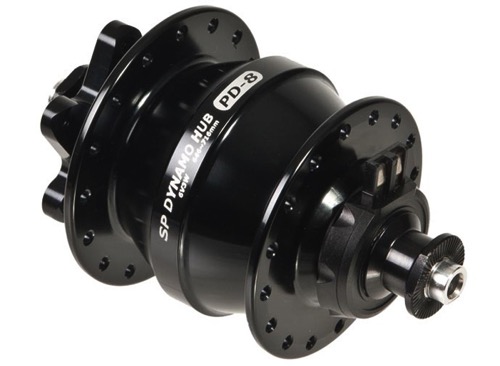
This is available from SJS Cyles for £95 at the time of writing. Alpkit also have a ‘Love Mud Juice’ branded version for £60 which appears to be the same thing.
There’s a slight weight and resistance penalty but I’ve never noticed the latter. Most dynamo hubs and accessories are based around a power rating of 6V / 3W. However the power which comes out of the hub is a little irregular and can lead to issues charging accessories. For instance the iPhone needs constant power for a few seconds before actually charging. The solution to this is a small cache battery which smoothes out these power fluctuations and provides a USB connector also. The best one on the market is the Busch & Müller USB-werk and is around £75 online. It’s pretty compact and comes with a lead to take the power from the hub to the unit via a water proof plug system so it doesn’t need to be on the bike when you’re not using it.
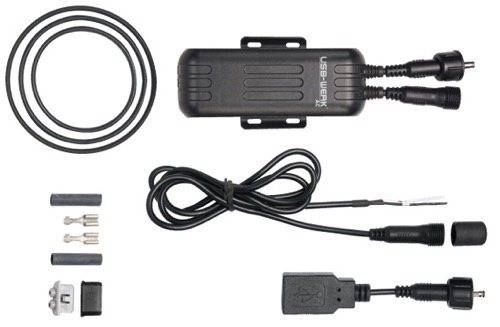
The other end of the unit has a tail where you connect, via another waterproof plug, a USB female connection. Plug your power only USB here and then plug into your Garmin. After a few hundred metres the cache battery will charge and then start kicking out power to the Garmin or phone mounted on your bars. Free power!
Careful not to get the USB connections wet as they are NOT waterproofed in any way and I recently had to replace one after it went rusty. Best to be kept in the dry somehow.
One option that seemed attractive when I was looking at these was some of the stem mounted USB caps where you run a wire inside the steerer and a USB plug appears on the top cap. A few issues stopped me using this solution – they’re really bloody expensive and secondly almost every long distance cyclist I’d read about said they had failed at some point. This is not surprising due to the female USB connector being exposed to the elements.
Lighting
Historically of course the whole point of a dynamo hub is to power a front and rear light. There’s some fancy kit out there but I went with the Supernova E3 Pro 2 (in black of course). Whilst only rated as 60 lux / 200 lumens I’ve found it to be plenty bright enough on dark country roads during an audax. Whilst it doesn’t look like much in town it is more than enough to see potholes ahead if rotated correctly. The cheapest place I’ve found is Rose Bikes for these.
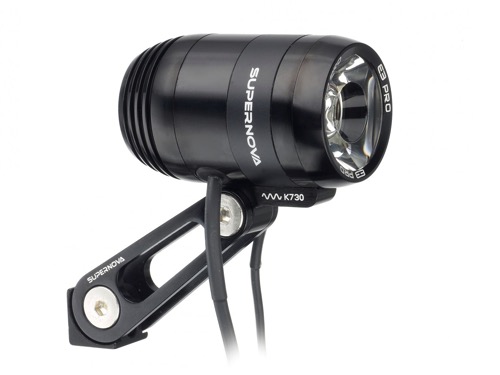
Whilst it doesn’t have the brute-force-scorch-your-eyes brightness of some of the battery powered bigger Exposure units it does make up for this in a really decent beam spread. There are lots of image comparisons of the beam patterns around if you’re so inclined. I’ve never had any problems seeing in pitch black lanes with it and it also has some side light which helps for sideways visibility at night. I have mine mounted on the fork crown although it can be bar mounted. Having it on the fork crown can create a tiny shadow from where it throws light over the front tyre but the can easily be adjusted out in the bracket. It moves in two places which is neat and not being on the bars is much nicer in my opinion. The problem often associated with dynamo lights is that when you’re not moving they stop. This and most modern dynamo lights designs have a stand light built in which lasts for five mins although at a lower power. This isn’t really enough to change a puncture with in pitch black so I usually have a small head torch or mini bar mounted light for this.
I also wanted a rear light to go with this and went with the compatible Supernova E3 Tail Light 2. This wires into the back of the front light NOT directly to the dynamo and again is best sourced from Rose Bikes. Both the ewerk-usb and the light are bi-wired into the same connector that clips onto the hub. It’s worth leaving a little slack here to allow it to clip on and off.
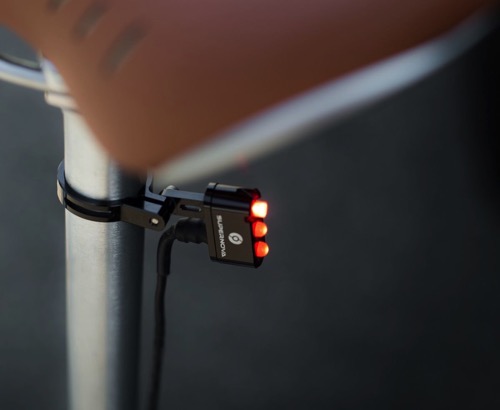
This comes in two versions – a seatpost mounted version and a rear rack mounted version. Both are pretty neat but the seatpost version comes with a thick rubber band mount not the metal mount as shown above. The metal mount is available separately from supernova directly and I was keen to get this as more permanent on the frame. The rear light is really really bright and also has a stand light.
I wired my light to the front light via the internal cable routing of my frame. The only visible wire is down the back of the seat tube and then goes up in the frame and joins a gear cable port on the way out. I had to modify this slightly to get an additional cable through. Internal cable routing is a huge pain but it does look so much neater.
The best thing about dynamo powered lights is that you can grab your bike and run out of the door and not worry about having charged your lights. It’s made my winter bike a joy to use and removed another source of anxiety from longer rides. I’ll always have light and my Garmin will always be powered.
It’s worth noting that running a powered device such as the Garmin and the lights at the same time is a bit problematic. The lights won’t reach full brightness and will flicker at slower speeds due to the power demands on the hub. The solution to this is to make sure you do all your charging during daylight hours and then switch to lighting during the night. So you’re back to the original power saving tips at the start of this post to get the best of this but I’ve not had any problems with this yet. You do need to actually disconnect the ewerk-usb fully though for this to happen otherwise the cache battery will still draw power.
The Supernova range isn’t cheap but if on a budget I would highly recommend the Busch & Müller system which I use on my town bike and again has been fantastic. I use the Lumotec IQ Cyo Premium T senso plus lamp which actually has a higher output than the Supernova at 80lux and is only £45 on Rose bikes. There is also a version of this which has a USB connector and cache battery built in although have not tested this myself.
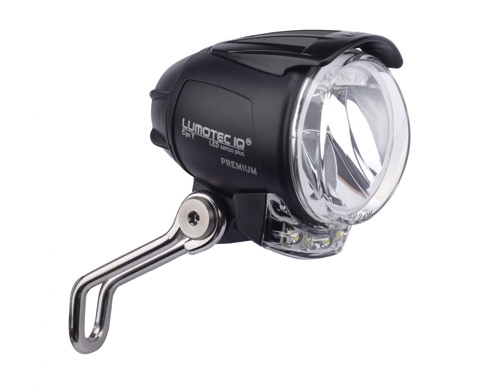
The rear light is the Busch & Müller Secula plus tail light which again is a very reasonable £13 on Rose bikes.

These are powered by a very big and heavy Shimano DH-3N31 NT dynamo hub that had a bolted axle for my fixed commuter bike – this was £20 on Rose although is considerably heavier than the SP Dynamo PD-8.
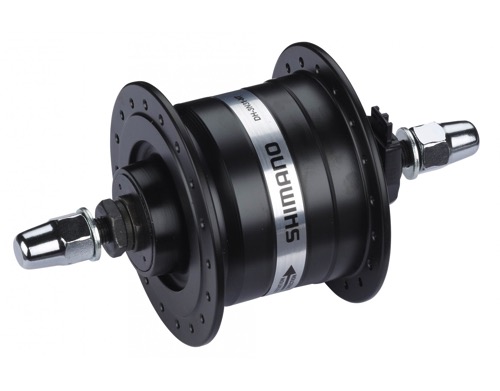
If I’ve missed anything in this post or something isn’t clear then please email me at info(at)andy-matthews.co.uk and I will update it.